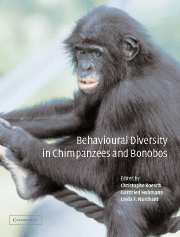Book contents
- Frontmatter
- Contents
- List of contributors
- Preface
- Behavioural Diversity in Pan
- PART I BEHAVIOURAL FLEXIBILITY
- INTRODUCTION
- 1 Multivariate and phylogenetic approaches to understanding chimpanzee and bonobo behavioral diversity
- 2 Chimpanzees in the dry habitats of Assirik, Senegal and Semliki Wildlife Reserve, Uganda
- 3 Behavioural adaptations to water scarcity in Tongo chimpanzees
- 4 Bonobos of the Lukuru Wildlife Research Project
- 5 Grooming-hand-clasp in Mahale M Group chimpanzees: implications for culture in social behaviours
- PART II SOCIAL RELATIONS
- PART III FEMALE STRATEGIES
- PART IV HUNTING AND FOOD SHARING
- PART V GENETIC DIVERSITY
- Index
4 - Bonobos of the Lukuru Wildlife Research Project
Published online by Cambridge University Press: 08 February 2010
- Frontmatter
- Contents
- List of contributors
- Preface
- Behavioural Diversity in Pan
- PART I BEHAVIOURAL FLEXIBILITY
- INTRODUCTION
- 1 Multivariate and phylogenetic approaches to understanding chimpanzee and bonobo behavioral diversity
- 2 Chimpanzees in the dry habitats of Assirik, Senegal and Semliki Wildlife Reserve, Uganda
- 3 Behavioural adaptations to water scarcity in Tongo chimpanzees
- 4 Bonobos of the Lukuru Wildlife Research Project
- 5 Grooming-hand-clasp in Mahale M Group chimpanzees: implications for culture in social behaviours
- PART II SOCIAL RELATIONS
- PART III FEMALE STRATEGIES
- PART IV HUNTING AND FOOD SHARING
- PART V GENETIC DIVERSITY
- Index
Summary
INTRODUCTION
Beginning in the early 1990s, intraspecies behavioural variations across a number of chimpanzee (Pan troglodytes) populations became the focus of increasing attention, and interspecies behavioural variations between chimpanzees and bonobos (Pan paniscus) have been the popular mainstay of bonobo recognition (variations such as female social role, use of social sex, etc.). Interspecies differences (larger groups, less aggression, and morphology) have largely been attributed to ecological variation across species ranges, bonobos having been considered to be isolated in an arboreal existence (MacKinnon 1978; Susman 1979) and restricted to a lowland, dense forest ecology. Behavioural diversity in wild chimpanzees first became evident by comparing tool use in the context of foraging as observed across populations inhabiting broad ecological conditions (McGrew 1992). The study of intraspecies behavioural diversity of bonobos is in its infancy, so ecological differences must be considered. When examining behavioural variation between bonobo study sites, White (1992) considered food provisioning at Wamba and the temporal effects of habituation at Lomako to explain variation.
In the relatively few years of bonobo field research, only two populations have been widely documented: Wamba (00°10′N, 22°30′E) and Lomako (00°50′N, 21°05′E). These two populations are both located within uniformly hot, wet, low-lying and flat topographies sheltered by closed-canopy, moist, evergreen lowland forest vegetation.
- Type
- Chapter
- Information
- Behavioural Diversity in Chimpanzees and Bonobos , pp. 61 - 70Publisher: Cambridge University PressPrint publication year: 2002
- 22
- Cited by

